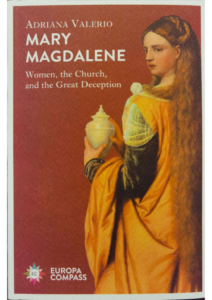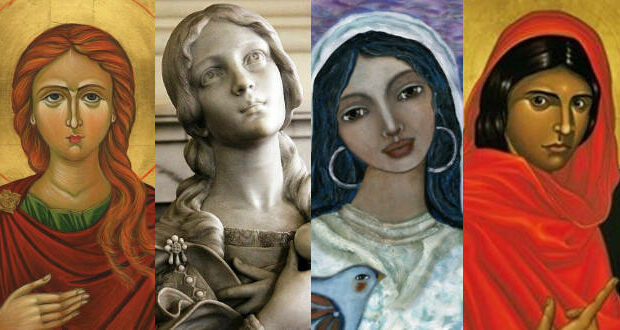One of the most misunderstood biblical figures has to be Mary Magdalene. Let’s start with what we do know about her. Sometimes referred to as Mary of Magdala or simply the Madeleine, she was a woman who, according to the Gospels, traveled with Jesus as one of his followers.
Mary Magdalene, along with Jesus’ mother Mary, witnessed His crucifixion, burial and resurrection. She is also mentioned by name a dozen times — more than most of the apostles — and is seen as someone who openly supported Jesus’ ministry.
 This is where the biblical version of Mary Magdalene ends and the speculation — fueled by interpretation, theologians and popes — begins. The unnamed “sinful woman” referenced in Luke 7:36-50 is never identified as a prostitute. In Jewish society at the time, “sinful” could have simply meant that she didn’t follow the law of Moses. This is where things got muddied.
This is where the biblical version of Mary Magdalene ends and the speculation — fueled by interpretation, theologians and popes — begins. The unnamed “sinful woman” referenced in Luke 7:36-50 is never identified as a prostitute. In Jewish society at the time, “sinful” could have simply meant that she didn’t follow the law of Moses. This is where things got muddied.
The notion that Mary Magdalene was a former prostitute dates to a narrative by Pope Gregory I during a homily he delivered in the year 591.
“She whom Luke calls the sinful woman, whom John calls Mary, we believe to be the Mary from whom seven devils were ejected according to Mark,” the pope said at the time. “What did these seven devils signify, if not all the vices? It is clear, that the woman previously used the unguent to perfume her flesh in forbidden acts. What she therefore displayed more scandalously; she was now offering to God in a more praiseworthy manner. She had coveted with earthly eyes, but now through penitence these are consumed with tears.”
In Pope Gregory’s interpretation, the seven demons expelled from Mary Magdalene by Jesus were transformed into the seven deadly sins of medieval Christianity. This notion is further fueled in the ensuing centuries by Western art and depictions of her in many famous paintings.
A new book by historian and theologian Adriana Valerio, “Mary Magdalene: Women, the Church, and the Great Deception” (Europa Editions) picks apart these false narratives and tries to set the record straight on one of the most important women in the Bible.
Valerio herself is a trailblazer. One of the first women in Italy to be a theologian, Valerio embarks on an investigation into Mary Magdalene’s life, using her 137-page book to delve into the myths, their origins and trying to separate fact from fiction. Valerio admits that Mary Magdalene’s image “preserves the hope of salvation.” It is this redemption that is so appealing to many Christians.
In fact, many tried to fill in the blanks regarding the vague details of Mary Magdalene’s life as stated in the Bible. As a result, she was depicted as a noblewoman, even wealthy, and someone who had committed adultery in her life. These notions all come together to fuel her myth in a collection of stories known as “The Golden Legend” written in 1260 by an Italian writer and Dominican friar Jacobus de Voragine.
If Mary Magdalene is none of these things, what should we make of her now? If not a sinful woman, then who is she? What was her role in Jesus’ life? These are the burning questions that this book isn’t afraid to try to answer. Valerio writes that the growing notion that Mary Magdalene may have been much closer to Jesus, even as a partner to Him, creates a “much more provocatory and complex argument” in the vain of Martin Scorsese’s controversial 1988 film “The Last Temptation of Christ” or author Dan Brown’s 2003 book “The Da Vinci Code.”
This search for the historic Mary Magdalene is something neither Scorsese nor Brown got right. Valerio, on the other hand, does a job similar to that of an investigator. Among her conclusions, Valerio notes, “Evidently, the recognition of female guidance and what role to entrust to women were subjects of intense debate within the communities of the first centuries, we have significant traces of this in the first Christian literature. In different groups from Asia Minor, there was a presence of Christian women who, in reference to biblical figures and often to Mary Magdalene, exercised prophetic, pastoral and ministerial functions.”
Eastern Orthodox traditions and Protestants largely rejected this notion of Mary Magdalene as a prostitute who found repentance, so much so that it was a major point of contention in the years leading to the Reformation. While the Mary Magdalene misconception — especially within Catholicism — rages on, Valerio’s work may not be as controversial as some would think.
For example, in 1969, Pope Paul VI removed the identification of Mary Magdalene and the “sinful woman” from the Roman calendar, but many still see her as a former prostitute. L’Osservatore Romano, the official Vatican newspaper, provided a blurb to Valerio’s book. The newspaper opined that Valerio “walks the reader through the history of the last 2,000 years, with the goal of revolutionizing the interpretation of the Gospels, and touching the very heart of Christianity.”
Indeed, this book is revolutionizing. As a reader, it is a fitting investigation to embark on during Women’s History Month. It’s a book that that will also leave some of you thinking and feeling differently about one of the Bible’s most-important female characters. Any book that can do that is worth a read.
Clemente Lisi is a senior editor and regular contributor to Religion Unplugged. He is the former deputy head of news at the New York Daily News and teaches journalism at The King’s College in New York City. Follow him on Twitter @ClementeLisi.
 Metro Voice News Celebrating Faith, Family & Community
Metro Voice News Celebrating Faith, Family & Community









